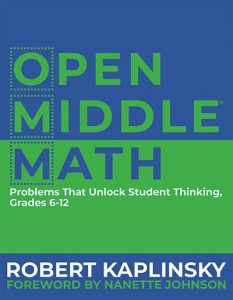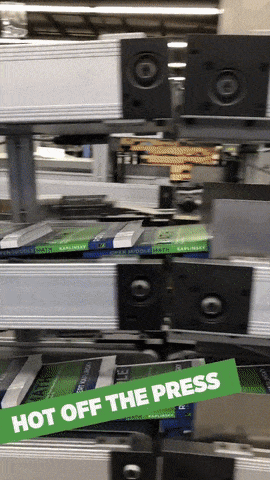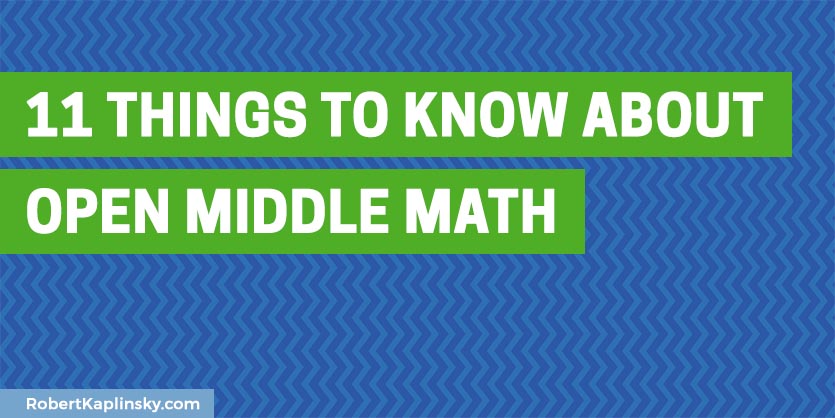 I’m so excited to share that after years in the making, my book Open Middle Math: Problems That Unlock Student Thinking, Grades 6 – 12 is finally done! I wrote Open Middle Math to help teachers facilitate powerful conversations around engaging problems that help students understand and love mathematics.
I’m so excited to share that after years in the making, my book Open Middle Math: Problems That Unlock Student Thinking, Grades 6 – 12 is finally done! I wrote Open Middle Math to help teachers facilitate powerful conversations around engaging problems that help students understand and love mathematics.
I wanted to tell you more about it so you have a better idea as to whether it’s something you’ll want to get a copy of.
GET PAPER BOOK GET KINDLE VERSION
Reading Open Middle Math: Problems That Unlock Student Thinking, Grades 6 – 12 is like having Robert as your thought partner as he strategically talks you through the rationale of planning for and implementing Open Middle problems.
I talk about how to facilitate powerful conversations around Open Middle problems using Peg Smith and Mary Kay Stein’s Five Practices of Orchestrating Mathematical Discussions as a model. Here’s what Peg Smith said:
This book is an amazing resource for teachers who are striving to help students develop both procedural fluency and conceptual understanding. Open Middle problems provide students with the opportunity to move beyond traditional procedural practice problems to explore mathematical relationships more deeply. In addition, Open Middle problems provide teachers with insights into what students really understand about the procedures they learned and with important formative assessment data they can use to modify instruction. This book is a very practical guide to implementing a new class of tasks that have the potential to improve student learning!
It includes specific examples of problems at 6th, 7th, 8th, Algebra, Geometry, Algebra 2, Trig / Pre-Calc, and Calculus. Here’s what Sara VanDerWerf said:
You need to read ‘Open Middle Math’ in your departments professional learning community this year. This book – check out the ‘choose your own adventure’ in Chapter 2 – has examples of the ‘what is an Open Middle Task’ for every grade/course from 6th grade to Calculus. This book is a roadmap for each person in your department to add tasks that will increase student interest, discourse and sense making no matter what they teach. Talk to your leaders about ordering this book today.
I wrote the shortest possible book I could write. There are no math teachers saying, “I wish this professional development book was longer.” So, I followed this design principle from Antoine de Saint-Exupery who said “Perfection is achieved, not when there is nothing more to add, but when there is nothing left to take away.” I cut out any part of the book that was not essential so that what remained would feel very worthwhile.
My book is both for people who are unfamiliar with Open Middle and veterans who’ve been using them for years. Here’s what Daniel Luevanos said:
I thought I knew everything about Open Middle problems until I read this book. Robert masterfully unpacks the complexity and beauty of these “simple” problems and captures why they play an essential role in students’ math experiences.
 It’s not just for secondary math teachers. While the example I use are for grades 6 through 12, the strategies I share can be applied to problems from any grade level.
It’s not just for secondary math teachers. While the example I use are for grades 6 through 12, the strategies I share can be applied to problems from any grade level.
It’s not a book where I talk about what an amazing teacher I’ve always been. I’ve also struggled to balance the way I was taught with the way I want to teach. I share all the bumps and bruises along the way so you can realize that they’re part of a process we all go through. Here’s what Lauren Baucom said:
Robert has always been willing to share his learning progress, struggles, and mistakes openly. Through his humility, he encourages readers to remember the joy that comes with productively struggling with a mathematics problem, and that we often learn more from the journey of solving than arriving at a solution.
It’s not a textbook for students. Instead, it’s a guide on how to take the kinds of problems you’re already using and enhance them to increase students’ learning and love of mathematics. Here’s what Dan Meyer said:
Robert offers teachers strategies for adding openness and richness to problems that are at first closed and meager. So take heart, teachers! The interest and learning of your students isn’t dictated by the problems in your textbook as you first find them, only by your imagination and design.
Robert meets every “what if” a math teacher can muster about implementing these tasks with his helpful, practical, play-by-play style. In reading and applying Open Middle Math, I feel like I have an experienced coach cheering me on!
Each chapter of this book stands alone, so you don’t have to read the whole book before you can implement what you learn. As you gain more experience and success using the problems, you’ll have more questions and can keep coming back to the book to give you support and push your thinking.
It meets Professional Learning Communities’ (PLCs) needs by showing how to authentically assess students and what to do with that information. Here’s what Carole Seubert said:
Open Middle Math provides a stimulating vehicle for aiding teachers in addressing the four Professional Learning Community (PLC) Essential Questions:
1) What do we expect our students to learn?
2) How will we know they are learning?
3) How will we respond when they don’t learn?
4) How will we respond if they already know it?
If you’re interested in getting a copy of the book, please use the buttons below. Or, if you have questions for me, please let me know in the comments.

